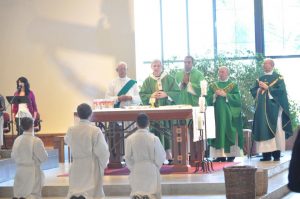This is our third in our blog series, which focuses on the second leg of the Catechism of the Catholic Church, “how we celebrate.”
 A few weeks ago in a homily I used the image of a 4-legged table to describe a holistic approach to our Catholic faith. If you remove one leg from a table, you can make it work depending on where you place objects on the surface. If you break off a second leg, you don’t have a very useful table. You might get inventive and prop the table in a corner, and get by, but you’d have to admit the limitations of the situation. Our faith stands on four legs, or pillars. The Catechism of the Catholic Church is structured to reflect these four pillars, and gives us a quick way of checking on the health of our spiritual table, on how authentically we are living our Catholic faith.
A few weeks ago in a homily I used the image of a 4-legged table to describe a holistic approach to our Catholic faith. If you remove one leg from a table, you can make it work depending on where you place objects on the surface. If you break off a second leg, you don’t have a very useful table. You might get inventive and prop the table in a corner, and get by, but you’d have to admit the limitations of the situation. Our faith stands on four legs, or pillars. The Catechism of the Catholic Church is structured to reflect these four pillars, and gives us a quick way of checking on the health of our spiritual table, on how authentically we are living our Catholic faith.
To sum up: The first leg is the doctrine of the Church, or what we believe as Catholics. The second leg is how we celebrate our faith and make God present, through liturgy and sacrament. The third leg is how we live as moral persons in line with the teachings of Christ. The final leg is how we pray. Our Catholic faith must stand on all four of these legs.
 The ‘second leg’ is an answer to the question: How does God continue to effectively give us
The ‘second leg’ is an answer to the question: How does God continue to effectively give us
the gift of Himself? Catholics have a sacramental understanding of God’s gift of life to us. Through the sacraments, which are expressed in our liturgy, visible signs make effective an invisible reality: the grace of God, the very gift of God’s life in our soul.
The word liturgein means ‘to make present or to re-present,’ a saving reality of God. The Eucharist, for example, makes use of the visible signs of bread and wine and of the words of Christ in order to fulfill his commandment to ‘take and eat’, so that we might
have divine life within us.
I am the living bread that came down from heaven; whoever eats this bread will live forever; and the bread that I will give is my flesh for the life of the world. The Jews
quarreled among themselves, saying, “How can this man give us (his) flesh to eat?” Jesus said to them, “Amen, amen, I say to you, unless you eat the flesh of the Son of Man and drink his blood, you do not have life within you. Whoever eats my flesh and drinks my blood has eternal life, and I will raise him on the last day. For my flesh is true food, and my blood is true drink Whoever eats my flesh and drinks my blood remains in me and I in him. (Jn. 6:51-56)
 It is clear, from these words of Jesus, that he intends to give himself to us sacramentally. This gift is not ‘just symbolic’, but is a true gift of God himself. The life contained in the sacraments is made effective through the saving sacrifice which Christ endured in his Passion. His life’s blood, poured out sacrificially on the cross, is the life of the Church. There is a wonderful depth, vividness and ‘down to earth’ quality to the sacramental and liturgical realties. For this reason Jesus clothed himself in our flesh, so that he could give himself to us through our senses, through our humanity. The liturgy celebrates this wonderful way of God’s relating to us, through which we are drawn into his life.
It is clear, from these words of Jesus, that he intends to give himself to us sacramentally. This gift is not ‘just symbolic’, but is a true gift of God himself. The life contained in the sacraments is made effective through the saving sacrifice which Christ endured in his Passion. His life’s blood, poured out sacrificially on the cross, is the life of the Church. There is a wonderful depth, vividness and ‘down to earth’ quality to the sacramental and liturgical realties. For this reason Jesus clothed himself in our flesh, so that he could give himself to us through our senses, through our humanity. The liturgy celebrates this wonderful way of God’s relating to us, through which we are drawn into his life.